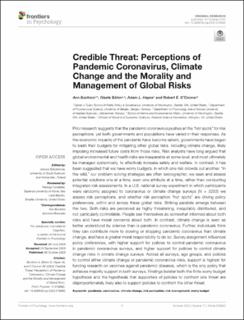| dc.description.abstract | Prior research suggests that the pandemic coronavirus pushes all the “hot spots” for risk perceptions, yet both governments and populations have varied in their responses. As the economic impacts of the pandemic have become salient, governments have begun to slash their budgets for mitigating other global risks, including climate change, likely imposing increased future costs from those risks. Risk analysts have long argued that global environmental and health risks are inseparable at some level, and must ultimately be managed systemically, to effectively increase safety and welfare. In contrast, it has been suggested that we have worry budgets, in which one risk crowds out another. “In the wild,” our problem-solving strategies are often lexicographic; we seek and assess potential solutions one at a time, even one attribute at a time, rather than conducting integrated risk assessments. In a U.S. national survey experiment in which participants were randomly assigned to coronavirus or climate change surveys (N = 3203) we assess risk perceptions, and whether risk perception “hot spots” are driving policy preferences, within and across these global risks. Striking parallels emerge between the two. Both risks are perceived as highly threatening, inequitably distributed, and not particularly controllable. People see themselves as somewhat informed about both risks and have moral concerns about both. In contrast, climate change is seen as better understood by science than is pandemic coronavirus. Further, individuals think they can contribute more to slowing or stopping pandemic coronavirus than climate change, and have a greater moral responsibility to do so. Survey assignment influences policy preferences, with higher support for policies to control pandemic coronavirus in pandemic coronavirus surveys, and higher support for policies to control climate change risks in climate change surveys. Across all surveys, age groups, and policies to control either climate change or pandemic coronavirus risks, support is highest for funding research on vaccines against pandemic diseases, which is the only policy that achieves majority support in both surveys. Findings bolster both the finite worry budget hypothesis and the hypothesis that supporters of policies to confront one threat are disproportionately likely also to support policies to confront the other threat. | |
